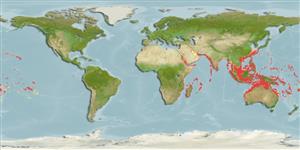分類 / Names
俗名 | 同種異名 | Catalog of Fishes(屬, 種) | ITIS | CoL | WoRMS | Cloffa
Environment: milieu / climate zone / depth range / distribution range
生態學
海洋 礁區魚類; 海洋洄游的 (Ref. 51243); 深度上下限 1 - 300 m (Ref. 28016). 亞熱帶的; 30°N - 32°S, 29°E - 123°W (Ref. 5222)
Indo-Pacific: Red Sea to South Africa and eastward to Ducie in the Pitcairn Group, north to Japan, south to New South Wales and Lord Howe Island. Migration report from the eastern Mediterranean Sea (Ref. 6489, 5385) may be based on Epinephelus coioides specimens.
印度-太平洋: 紅海到南非與向東至皮特凱恩島群的迪西,北至日本, 南至新南威爾斯與羅得豪島。 遷移報告從地中海東部 (參考文獻 6489,5385) 可能是以 點帶石斑〔Epinephelus coioides〕 標本為依據。
Length at first maturity / 大小 / 重量 / 年齡
Maturity: Lm 61.1, range 61 - ? cm
Max length : 100.0 cm TL 雄魚/尚未辨別雌雄; (Ref. 89972); common length : 90.0 cm TL 雄魚/尚未辨別雌雄; (Ref. 5450)
背棘 (總數) : 11; 背的軟條 (總數) : 13 - 16; 臀棘: 3; 臀鰭軟條: 8. Color of head and body pale greenish grey or brown with round dark spots that vary from dull orange-red to dark brown, centers darker than the edges. A large black blotch (or group of black spots) often visible on body at the base of last 4 dorsal-fin spines. Five sub vertical dark bars may be present on body. Dark spots on soft dorsal, caudal and anal fins of juveniles are so close that the pale interspaces form a white reticulum. 95-112 scales in longitudinal series. Scales on body ctenoid in juveniles, becoming cycloid in adults except the area beneath and posterior to pectoral fins. Pyloric caeca 16-18. Further characterized by: elongate body, depth contained 3.0-3.6 times in SL; large head, length is 2.1-2.4 times in SL; snout length 2.0-2.4 times in upper-jaw length; interorbital area narrow, flat to slightly concave, interorbital width 6.8-8.1 times in HL and 3.1-4.0 times in upper jaw length; broadly rounded preopercle, serrae at angle of preopercle slightly enlarged; upper edge of operculum almost straight; posterior nostrils distinctly larger than anterior nostrils; maxilla reaching well past eye, greatest width about twice suborbital depth, maxilla width 6.8-8.1% of standard length; upper-jaw length 21-24% of SL; 2-5 rows of teeth on midlateral part of lower jaw; inner teeth at symphysis of upper jaw are longer than the fixed canines at front of jaw (Ref. 89707). Differs from E. howlandi by its more elongate body and closer-set spots (Ref. 37816).
頭部與身體的顏色灰白的呈綠色的灰色或褐色的有改變的深色圓斑從暗橘紅色到深褐色的, 中心比邊緣顏色更深。 一個大的黑色斑塊 (或群體的黑色斑點) 時常看得見的在最後 4根背鰭棘的基底的身體上。 五條接近垂直的深色橫帶可能是位於身體之上。 在稚魚的軟背鰭、尾鰭與臀鰭上的深色的斑點是如此的接近以致於 , 灰白的間隙形成一個白色的網狀質。 在縱向的系列中的 95-112個鱗片。 在身體上的鱗片有櫛鱗的在稚魚中,變成圓形當成魚時除胸鰭下面與後面的區域。 幽門盲囊 16-18. 用它的更多的細長的身體與較靠近的斑點有別於 E. corallicola 與 E. howlandi 。 (參考文獻 37816)
Adults prefer clear water areas on coral reefs; juveniles have been taken from reef flats and in tide pools, adults found in deeper waters. Solitary and common in lightly fished areas (Ref. 37816). Adults from Oceania almost exclusively feed on fishes (holocentrids, mullid, and pomacentrid); and occasionally, crustaceans (Ref. 89707). Present in the Hong Kong live fish markets (Ref. 27253). Minimum depth reported taken from Ref. 30874. Occasionally ciguatoxic (Ref. 37816). Reports of sizes in excess of 80 cm total length for E. tauvina are probably based on misidentifications of E. coioides, E. malabaricus, and E. lanceolatus; these species grow much bigger than E. tauvina (Ref. 5222, Heemstra pers. comm. 09/04).
.
在珊瑚礁上偏愛清澈的水域; 稚魚曾經取自礁石平臺而且在潮池中,成魚發現於較深的水域了。 獨居性與常見於輕輕的捕獲區域.(參考文獻 37816) 來自大洋洲的成魚幾乎只吃魚 (holocentrids , mullid 與雀鯛科) 。 在香港活魚販售。 (參考文獻 27253) 最小深度報告取自參考文獻 30874. 偶然地有西加毒的.(參考文獻 37816) 給 E. tauvina 的超過 80 公分全長的大小的報告是可能以 E. coioides 的誤鑑為依據
, E. malabaricus, 與 E. lanceolatus; 這些種生長比 tauvina 大許多 (參考文獻 5222, Heemstra pers. comm。 09/04).
。
印度-太平洋: 紅海到南非與向東至皮特凱恩島群的迪西,北至日本, 南至新南威爾斯與羅得豪島。 遷移報告從地中海東部 (參考文獻 6489,5385) 可能是以 點帶石斑〔Epinephelus coioides〕 標本為依據。
Heemstra, P.C. and J.E. Randall, 1993. FAO Species Catalogue. Vol. 16. Groupers of the world (family Serranidae, subfamily Epinephelinae). An annotated and illustrated catalogue of the grouper, rockcod, hind, coral grouper and lyretail species known to date. Rome: FAO. FAO Fish. Synop. 125(16):382 p. (Ref. 5222)
人類使用
漁業: 低經濟; 養殖: 商業性; 游釣魚種: 是的
工具
特別的報告
下載 XML
網路資源
Estimates based on models
Preferred temperature (Ref.
123201): 19.6 - 28.2, mean 26.2 °C (based on 1115 cells).
Phylogenetic diversity index (Ref.
82804): PD
50 = 0.5000 [Uniqueness, from 0.5 = low to 2.0 = high].
Bayesian length-weight: a=0.01202 (0.01042 - 0.01387), b=3.04 (3.01 - 3.07), in cm total length, based on LWR estimates for this species (Ref.
93245).
營養階層 (Ref.
69278): 4.1 ±0.68 se; based on food items.
回復力 (Ref.
120179): 低的, 最小族群倍增時間4.5 - 14 年 (K=0.1-0.17; tm=5-6; Fec = 354,989).
Fishing Vulnerability (Ref.
59153): High vulnerability (59 of 100).
Climate Vulnerability (Ref.
125649): Very high vulnerability (78 of 100).
Nutrients (Ref.
124155): Calcium = 11.8 [4.7, 25.6] mg/100g; Iron = 0.477 [0.234, 1.002] mg/100g; Protein = 19.2 [17.5, 20.7] %; Omega3 = 0.195 [0.108, 0.367] g/100g; Selenium = 25.5 [12.4, 56.4] μg/100g; VitaminA = 117 [27, 467] μg/100g; Zinc = 0.625 [0.409, 0.950] mg/100g (wet weight); based on
nutrient studies.
